
By Veruis, August 20, 2019

Hey everyone, I am Veruis, a casual player of CCG and RPG games, and I love spending my time having fun instead of tryharding on ladder. That is why I decided to combine my strength with Team Aretuza and prepare for all of you something to help with the best mode in Gwent: Seasonal. Enjoy!

Seasonal Mode Guide: Season of the Draconid
We współpracy z Gwint24.pl, artykuł jest również dostępny tutaj.
20 August 2019: We’ve just updated this guide with one additional deck for each faction!
What Is Seasonal Mode?
Seasonal Mode is a special game mode, rotating each month, with a unique ruleset where you fight another player. To join the queue, you need to be at least Level 10.

Playing this mode allows you to complete some quests in the seasonal Reward Tree. Also, this mode is the best place to complete contracts quickly, which will grant you Reward Points (RP). While spending RP, you will encounter special nodes marked with a chalice. Some of these will stop you from proceeding further until you finish a quest. A few of them can be done exclusively in seasonal mode, but most can be done in any mode in game.
What if I don’t have time and reward points for this season’s Reward Tree?
Fear not! CDPR provides a solution: Each month, you can find a Seasonal Bundle in the store which contains everything that was available in the season four month prior with an additional bonus cosmetic, a new border or an avatar. Accordingly, the Seasonal Bundle of the Season of the Draconid will be in the store in December 2019.
Season of the Draconid

This month, you fight for the Draconid card back, three unique avatars, four Draconid borders, and two premium Wyverns. To complete the Season of the Draconid Reward Tree, you require 85 RP, while the fastest way to the Archgriffin border requires 42 RP. To complete the Leader Tree (Saskia), you need 80 RP, while the fastest way to the Draconid card back requires 46 RP.
The Rules
“Both players have just 8 seconds to complete their turn and 15 seconds to complete the redrawing phrase.”
Are you tired of ropers ( ) waiting until the last second to play a card? Then you will love this mode!
) waiting until the last second to play a card? Then you will love this mode!
Rules for this Seasonal are simple. You need to be faster than Usain Bolt, than Flash, than a Acinonyx jubatus, than… I suppose you get the point. There is no time to think, no time to convert your brilliant ideas into a masterful plan, no time even to properly do the math. There is only one rule you need to follow: Slam points on the board!
The idea for this mode is to build your deck with cards that don’t have long animations, don’t require more than two clicks, and can be placed swiftly and without too much preparation. It’s also very important to be familiar with the abilities of the cards in your deck.
Below, you will find my recommendations for the best cards for this month’s Seasonal Mode as well as deck suggestions that work very well in this mode and are fun to play. I don’t think there is one particularly strong faction in this month’s Seasonal Mode. Monsters, Skellige, Scoia’tael, Nilfgaard and Northern Realms look pretty good, while Syndicate, because of its many Fee abilities, stays behind. However, each of the decks presented below requires some experience to pilot it properly. There is just not enough time to figure out things on the go!
There are many playable decks and I highly recommend finding your own list for this season. Even Eldain or Queen Calanthe are fine if you are familiar with the cards included in the respective decks.
This mode is also the perfect place for people who are looking for fast games to complete dailies, quests and contracts.
Remember that seasonal mode is mostly for fun and adjusting your deck to your playstyle is more important than winning.

This month, we have fewer and less valuable neutrals than in the Season of the Griffin. After the latest balancing patch, most neutrals are struggling to compete head-to-head against the buffed faction cards. However, there are some neutrals that can be used as fillers to further the general idea of a deck.
Cards with good value on their own:
- Geralt of Rivia - There are too many point-slam cards in this Seasonal Mode to not play one of the best tall removals in the game. It may brick against more control-oriented decks, so always think about whether having Geralt in hand is game-winning or if you should mulligan it.
- Regis: Bloodlust - Good removal with Banish potential.
- Moon Dust and Northern Wind - Fine specials that can find a place in every deck if you are looking for removal.
- Eskel: Pathfinder - Proactive play, not as good as similar faction cards. But if you have some free provisions and nothing better to include in your deck, Eskel is a good choice. It doesn’t require your attention after you place it on the board and it generates a decent amount of points in long rounds.
- Ciri: Dash - With there being less removal in the game now, Ciri looks very promising in this mode, especially in decks that focus on boosting.
- Roach - With almost not even enough time for basic plays, our best girl is a good addition for tempo and thinning.
- Carlo Varese - Good removal potential. Excellent choice for players with fewer scraps.
- Yennefer of Vengerberg - Works perfectly in swarm decks and with Queen Meve.
- Doppler - Fine value card, especially in decks with a lot of the same primary category, like Queen Meve decks with many Humans.

Do you remember what rule you need to follow this month? Slam points! And there is only one real point-slam faction: Monsters.
Let’s be honest, Monsters are quite weak now on the competitive ladder. With Northern Realms shining and the buffs to the other factions, Monsters are definitely dropping out of the race - at least for now. However, in this Seasonal Mode, they provide a simple tactic with solid points that doesn’t require high APM skills.
There are a bunch of decks that can be built with Eredin Bréacc Glas, Unseen Elder or Woodland Spirit. However, the best Monsters leader in this mode, even with a higher number of animations, is Gernichora.

Guide
This is a simple and straightforward deck. Playing cards from the weakest (like Nekker) to the strongest (Old Speartip) provides you with a lot of points that don’t require too much planning and also allow for a few possibilities to interrupt an opponent’s game plan without losing tempo.
While playing this deck, it’s important to pay attention to your opponent’s tactic. Sometimes, it is better to keep Drowner or Whispess in hand to stop opponent engines before they get out of control.
Your starting hand should have cards from the whole provision range. Although Ghouls and Ozzrel are great cards, they are your mulligan targets for Round 1, as you need to prepare your graveyard first with Ice Giants, Griffins and Old Speartip: Asleep. Keep in mind that Wild Hunt Riders are good thinning tools but have Dominance, which requires them to be played when you have the strongest card on your side of the board. The condition is also fulfilled when both players have an equally strong strongest card.
Possible Replacements
The list presented here includes mostly point-slam cards with a little control, like Carlo Varese. If you prefer even more immediate value, I suggest swapping out Carlo for another card with high base power, like Katakan or Golyat. Similar with Alzur's Double-Cross: If your drawing-golds skill is good enough, Alzur's could be replaced with one of the point-slam cards mentioned previously.
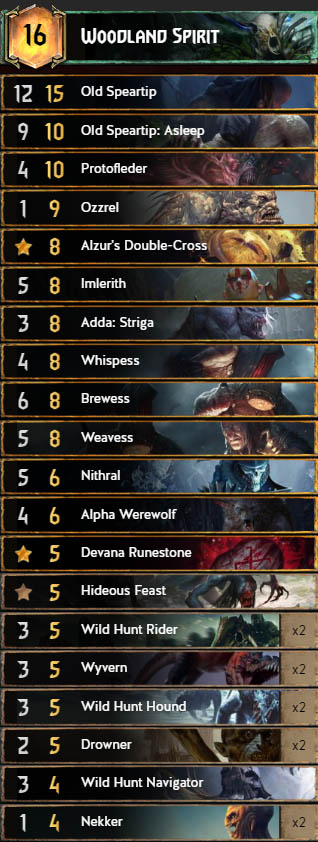
Guide
How to assert dominance over your opponent? Well, play a Dominance deck like this one!
This list contains cards with two important keywords: Dominance and Thrive which are supporting each other. Keep in mind that cards with Dominance don’t proc on Deploy, that’s why you need to already have a highest unit on the battlefield. Ensuring Dominance can be achieved with high-value cards like Old Speartip, Old Speartip: Asleep, the Crones (Brewess, Whispess and Weavess) or with Hideous Feast. There is also the possibility to use Woodland Spirit's leader ability which grants 8 points on a unit in hand, but remember: By doing that, you are exposing yourself to very juicy tall removal, which is why you should use it only when in urgent need or on a low-point unit, like Wild Hunt Rider or Wild Hunt Hound.
This deck is also not only about point-slamming, but also about disrupting your opponent’s board with cards like Adda: Striga, Imlerith, Whispess, Protofleder and Drowners. Devana Runestone is an RNG card, but Monsters has pretty good synergies within its faction, so sometimes it’s fun to use it and highroll into something useful. Also, Nithral is an interesting choice because I encountered a lot of Portals, Svalblod Totems or Summoning Circles.
Let’s move to mulliganing. Fortunately, there is nothing unusual. Keep the second copy of Wild Hunt Rider in the deck, the same applies to Ozzrel in Round 1, and then try to find better cards than you already have. Keep in mind that Nithral is mostly a tech card, which is why you should always keep it against Eldain and sometimes Skellige leaders. In other matchups, it depends, but mostly it is good to mulligan Nithral away. Drowners, with their ability to move things on the board, should be kept in hand against Northern Realms or other decks that run many rowlocked engines.

After hours of struggle to find the correct Nilfgaard list, I came to only one conclusion: NG doesn’t mean “Nilfgaard”, it means “Not Good”. At least this patch. However in the end, I was able to come up with a, let’s say, playable list with Ardal aep Dahy, which mostly focuses on disrupting the opponent’s game plan. While the meta is mostly engine-focused, Ardal can be a very good pick; but remember that even with correct plays, Ardal may struggle to find points.
There is also a version of this deck including a Soldier package, with cards like Slave Infantry, Daerlan Soldier, Vreemde and Vrygheff. If you’re facing a lot of Northern Realms or Monsters in Seasonal, which are slamming point after point, the list with Soldiers hardly falls behind.
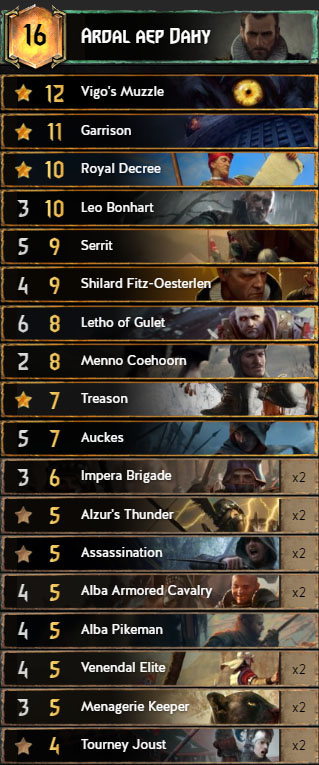
Guide
There is nothing complicated in this deck. With only a few proactive plays, like Venendal Elite and Shilard Fitz-Oesterlen, you should focus on the opponent’s side of the board. However, it may take some time to properly execute this deck’s game plan, which is difficult without experience. But experience can be gained pretty quickly – games are short and in half an hour, you will have all necessary knowledge to beat your opponents.
The most important thing with this deck is to identify what your opponent might be playing during the mulligan phase. Leo Bonhart or Geralt of Rivia may brick, so it’s sometimes better to mulligan these cards, especially against Eithné or Crach an Craite.
You should mulligan different cards in different matchups. Against Queen Meve or Filavandrel aén Fidháil, you would like to have cards like Assassination or Alba Armored Cavalry; however, against the point-slam decks Gernichora or Arnjolf the Patricide, you prefer to keep your own high-point cards, like Garrison, to prevent Gernichora from fulfilling Dominance requirements. Venendal Elite and Treason should be used in Round 1, because they rarely find value in a short Round 2 or 3.
A few last tips: Venendal Elites should be kept only with at least three or more Tactics in hand. Also, if you keep Menno Coehoorn and would like to use it as a tutor for Royal Decree, remember that you have to perfectly calculate your 8 seconds time to fulfil this combo. That means it rarely works.
Possible Replacements
Alzur's Thunder, which is a Spell and not a Tactic and it doesn’t affect the power of Ardal's leader ability, can be switched for something that suits you more, for example another Tactic like Imperial Diplomacy. It is also possible to replace more costly Tactics like Garrison or Treason. On the other hand, you can increase the number of units in your deck by adding Nilfgaardian Knight or Imperial Diviner, which can help against lists with Bleeding or Vitality.
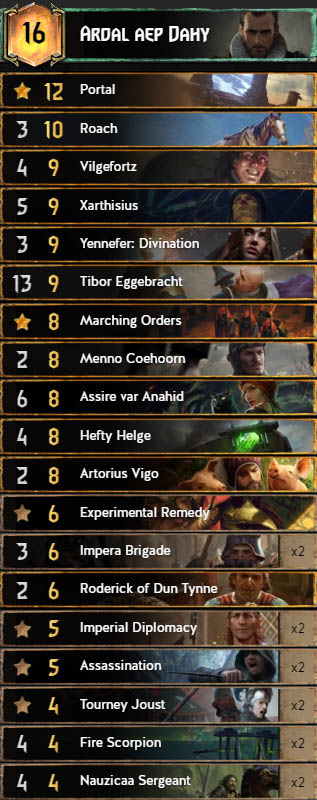
Guide
And another deck with Nilfgaard’s superior leader, Ardal aep Dahy. I think everyone, who plays actively, is familiar with this list. If I recall correctly, it was introduced by Redrame and it hit the bull’s eye.
Hyperthin has a straightforward plan: With all your thinning tools, like Portal, Menno Coehoorn and Roderick of Dun Tynne, you thin to one last card which stays in deck to almost the end – Tibor Eggebracht. Then, with Xarthisius and Yennefer: Divination, you Reveal Tibor, boost your cards for 13 points and finish the game with Vilgefortz on your lowest unit which Summons Tibor onto the board. Because you are vurnerable to bleeding, cards like Hefty Helge, Assassination and Fire Scorpions help you to win Round 1. Each battle requires a lot of attention to avoid overcommitment. In the end, your power plays rely on Tibor, which not always will be hit with Yennefer or Xarthisius if the deck has not been thinned to exactly one card.
Mulligans are an important part of leading this deck to victory. Keep in mind that Portal needs at least two units of 4 provisions, so always mulligan Fire Scorpion and Nauzicaa Sergeant to avoid bricking Portal. This is the reason why this deck only contains two pairs of 4-provision units. To properly execute this deck’s game plan, it is very important to use Artorius Vigo to thin Impera Brigade, which is why you should always mulligan those cards. As for Tibor Eggebracht, you don’t need to always mulligan it away. Sometimes, this card can stay in hand to not brick Roderick of Dun Tynne or to try to avoid your opponent’s Viper Witchers or Traheaern var Vdyffir.
In the end, I feel like this list is interesting in Seasonal Mode, but it requires a lot of experience in piloting.

Season of the Draconid could also be called Season of the Northern Realms. After this month’s patch, the North will not tuck tail and beg for mercy, neither on ladder nor in Seasonal Mode. The North will roll over all of its enemies without pardon.
There are two leaders I would not use while deck-building: Queen Calanthe and King Demavend III. Calanthe’s animation takes too long to complete and, thus, often ends in Discarding a card to your graveyard. Demavend just doesn’t fit into this mode; there is simply not enough time to use its Charges. The other NR leaders are definitely playable, with Queen Meve and King Foltest being the best.
There are two archetypes that can be taken into consideration: Meve Boost and Foltest Swarm, while the second one requires a high APM skill not to lose cards. I will focus on a Meve deck because I think it’s more player-friendly (especially console users).
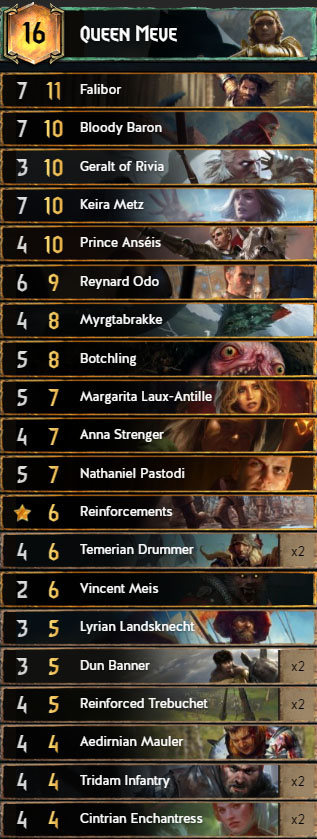
Guide
There is not much to talk about in this list. With cards like Anna Strenger, Keira Metz, Tridam Infantry and Reinforced Trebuchet, you can outvalue almost everything you face, while Prince Anséis, Falibor, Myrgtabrakke or Margarita Laux-Antille provide control against your opponents’ tactics.
Depending on your matchup, you must think more about avoiding cards like Scorch or Geralt: Igni by playing around them or focus on your own engines while facing point-slam decks like Gernichora. When playing against Northern Realms in a mirror, it’s better to go first and attempt the 2-0. Of course, the decision should only be made after carefully evaluating your draws and mulligans. But remember… the clock is ticking...
Mulliganing is very easy in this deck. Considering your matchup, you either keep Geralt of Rivia/Vincent Meis or not. If you don’t have or need Geralt or Vincent, you mulligan just your worst cards, starting with Aedirnian Mauler or Cintrian Enchantress.
Possible Replacements in the Deck
- Kaedweni Sergeant, Temerian Infantry, Lyrian Landsknecht, Aedirnian Mauler or Battering Ram can be swapped for any bronze already in the deck.
- Likewise, Queen Adalia, Seltkirk of Gulet, Nenneke, Ves, Vissegerd or Prince Stennis can replace any gold in this list.

Guide
The Season of the Northern Realms continues. King Foltest, the unconditional leader of the competitive ladder, finds its place also in Seasonal Mode. With reinforcements from Meve’s army – Prince Anséis, Tridam Infantry, Anna Strenger and Reinforced Trebuchets – combined with some special forces, Blue Stripes Commandos and Blue Stripes Scouts, this deck brings chaos and destruction into this lovely mode.
This deck is more draw-dependent than the Queen Meve version, but it also can be more powerful in short rounds. With access to Commandos and Scouts, you can start generating a sort of carryover for the next round by copying Commandos in the deck, bringing them out onto the board with their Order and into the next round by replaying them by putting them back into your deck with Princess Pavetta. However, if this combo remains incomplete due to, for example, bad draws, your engines are coming to the rescue. With a similar tactic to the Meve deck shown above, Anna Strenger, Temerian Drummer and Cintrian Enchantress keep engines like Tridam Infantry or Reinforced Trebuchets going. They also allow for the possibility to get greedy and boost Seltkirk of Gulet or Prince Anséis before using their Duel abilities.
Mulliganing is as simple as building a flail. If you have any pieces of the Commando combo, you should try to find Roche: Merciless and Blue Stripes Scouts to seal your opponent’s destiny. Of course, you don’t want to have two copies of Commando or even any of them if you are in Round 3 with Roche and a bunch of special forces in your deck. If mulliganing doesn’t like you, then just find engines and try to win on even when going second or when going first, try to not lose. Bleeding the opponent with Commandos in Round 2 is also an option.

While I was creating the deck for Scoia’tael this season, I came to the conclusion that there are only two viable leaders – the rest have too long an animation to be playable. Those leaders are Brouver Hoog and Filavandrel aén Fidháil. However, for true masters of smashing LMB, Eithné can also be a thing. Still, Dwarf decks seem more powerful here than an unreliable version of Eithné Control.

Guide
Dwarfs are pretty awesome this patch, as they require few interactions, even the ones with Orders like Paulie Dahlberg or Dwarven Mercenary. Novigradian Justice grants bodies for synergy with Barclay Els or The Great Oak. However, it is still Scoia’tael with Sheldon Skaggs – winning the coinflip (going second) is very important when you have Dwarven Agitators and Sheldon in hand.
Also, I would like to share my opinion on Brouver, which may look worse than Filavandrel: Brouver lets you activate Mahakam Defender and set up more bodies for Oak. Simultaneously, with rowlocked cards encountered everywhere after the latest patch, Brouver leaves you with an important decision: Use its Charges on your units or disrupt your opponent’s plan? It’s all up to you. It’s best to use Brouver’s Charge first, and no more than one per turn to not waste it– or a card.
This deck is highly synergistic, so there is only one thing to care about: not bricking Novigradian Justice. You should keep at least one Dwarven Mercenary/Cleaver's Muscle in deck and try to have Sheldon Skaggs with handbuff cards like Ithlinne Aegli and/or Dwarven Agitator in hand at the same time.
Possible Replacements
It’s hard to find proper replacements in this deck because it includes almost all the Dwarves available in the game right now. However, there are still Zoltan Chivay and Dennis Cranmer which can find their place in the deck after cutting Ithlinne Aegli or Regis: Bloodlust.
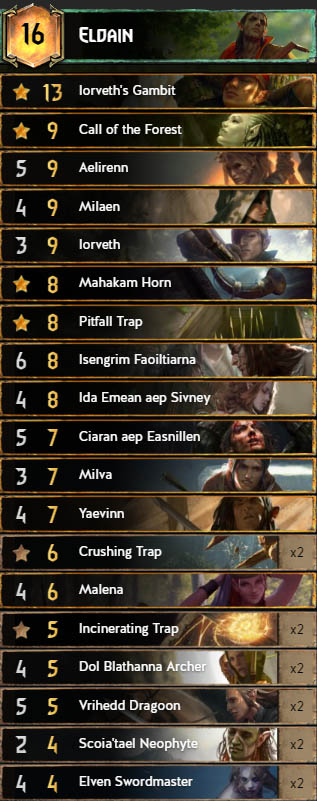
Guide
Guess what is the biggest surprise of this season. And no, I’m not talking about Ardal aep Dahy being viable. It’s Eldain and its Traps! Buffs introduced in this patch brought Elves and Traps to quite the nice power level, which is why it’s a good time to use Eldain in this mode to complete its Mastery contract.
While playing this deck, you must pay attention to multiple things at once and always be at least one turn ahead of your opponent. Always count how many Elves you have on the board to keep track of when Aelirenn will be pulled from your deck. Keep an eye on the number of Traps left in the deck to not brick Iorveth's Gambit. It’s also important to think about what Traps you would like to tutor from your deck; for example, using both Crushing Traps at once in the beginning of a round may be a bad idea. Pitfall Trap must be used in different moments in different matchups: It could be the Trap you play last when facing Monsters to catch their Ozzrel or it may be one of the first when facing Ardal Tactics to destroy their Venendal Elite. The appropriate guess requires a little bit of experience. Malena and Vrihedd Dragoon disrupt your opponent’s strategy with their movement abilities and they align more bodies for Crushing Trap. With Call of the Forest, you can replay important cards like Ciaran aep Easnillen or Ida Emean aep Sivney or you can use it to play another Elf from your deck while shuffling back Aelirenn.
When it comes to Eldain's Charges, it’s important to remember to use them in different turns. Do not save them until your last play because you won’t have the time to use them. Also, they can help you secure Round 1 and sometimes, they can help you out when you are being bled.
As for mulligan targets, try to keep a mix of Elves and Traps to eventually adjust your strategy as the battle goes. Also, you should keep Aelirenn in the deck, but if you don’t feel confident in a matchup, it may be a good idea to keep it in hand and mulligan it in Round 2 to have bonus points when your opponent bleeds you. Remember: As I mentioned before, try to always keep two Traps for Iorveth's Gambit in the deck.

Skellige is not backing down, even this month. While most of the best buffs avoided the clans, they are still a tremendous threat to everyone. Skellige lists for this Seasonal Mode are quite similar; most of the time, they only differ in leaders and specific combos, like Harald the Cripple and Dagur Two Blades or Arnjolf the Patricide with Svanrige Tuirseach.
One last thing: Do not trust bald guys.

Guide
This list has existed since June, so you are probably familiar with it. Try to not expose yourself to tall removal while keeping an eye on the opponent and shutting down their engines. However, with all the recent nerfs to removal, I decided to include more neutrals in this list, like Carlo Varese or Regis: Bloodlust, as sometimes it is necessary to prevent some cards from staying on the board for too long.
While facing engine-focused decks, do not be afraid to use your leader ability to destroy them, even at the beginning of Round 3. Getting those sweet 8 points on Dagur is less important than preventing the snowballing of your opponent’s engines.
Mulliganing is like always: Try not to brick Drummond Shieldmaiden and replace the weakest cards while trying to find Hjalmar an Craite, Skjall, Vigo's Muzzle and Dagur Two Blades.
Possible Replacements
- If you want to go for a more greedy list, you can replace Regis: Bloodlust and Carlo Varese with Olaf and Knut the Callous while upgrading one of the bronzes (for example, An Craite Marauder for An Craite Longship).
- Changing leaders is a nice idea, especially if you are farming contracts, but remember to swap in cards that support your leader.
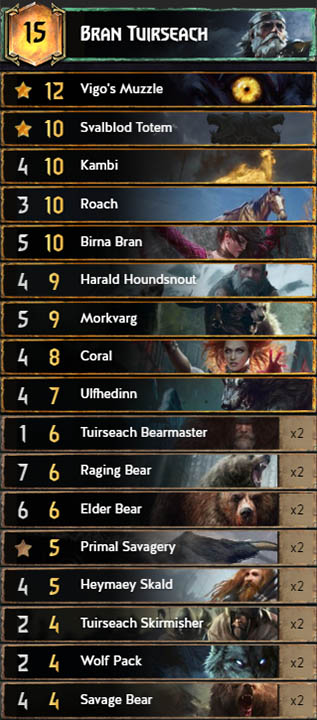
Guide
It’s not its season, but Wojtek wants to play too! Under the command of Bran Tuirseach, bears are looking for pabulum and someone to… play with. However it’s rarely safe for their playmate.
Bear Bran has never been particularly strong, but it is still fun to play, especially in this mode. With very little control – Vigo's Muzzle – this list focuses on slamming points: First, with the Discard mechanic using Birna Bran, Coral, Heymaey Skalds and Tuirseach Skirmishers and second, when all the Beasts are in the graveyard, with Tuirseach Bearmasters. I also included Kambi, which is 100% a meme card, but I like to use it as an element of surprise. And, of course, because it has the Beast tag.
In your starting hand, you would like to have the cards from the Discard package and less valuable Beasts like Wolf Pack or Savage Bear. Also, Coral should be combined with a special card like Primal Savagery.

And here comes the Syndicate, Terror of the Ladder... And definitely the worst faction to play in this Seasonal Mode. The biggest advantage of this faction, the Fee mechanic, is the worst possible thing in this mode. That’s why, if I may suggest something, avoid playing this deck, unless you really need to.

Guide
I will be honest with you. The deck presented here is bad. Finding the correct list for the most synergistic faction in the game should not be a pain, but it was. Syndicate focuses on generating Coins and spending them with cards that mostly have Fee or Tribute abilities. These abilities, however, have long animations, which is why I cut most of the engines, like Ewald Borsodi or Witch Hunter Executioner. In the end, I have this: A deck with one “clickable” engine, Hvitr and Aelydia, and a lot of midrange cards. Portal is used to get out bad 4-provision cards and thin the deck to find Moreelse, Carlo Varese, Sigi Reuven, Adriano the Mink – did you know that this art shows a CDPR employee? – or Myrgtabrakke.
A good Round-1 hand, especially when going first, is filled with less important cards like Eavesdrop, which helps you go through your cards, Sewer Raiders, which… does the same as the previous card, and some more valuable cards to win a round.
If you really want to play Syndicate in this mode then one last tip: Mulligan The Flying Redanian and a second copy of Sewer Raiders. You are screwed enough as is.
Possible Replacements
Sometimes, this deck suffers from a lack of Coin spenders; that’s why you may drop Sigi Reuven for a tall removal like Geralt of Rivia and promote a bronze into Oxenfurt Naturalist or Arena Endrega.

Guide
Another strategy that might be worth considering for this Seasonal is Crimes under the command of Cyrus Hemmelfart, commonly simply known as Fart. Besides some obvious problems like using multiple Fees or leader Charges in one turn, this list is probably one of the best options for Syndicate. Playing the Bounty package is theoretically more points; however, sometimes you might not have enough time to play your turn optimally, no matter how good your APMs are.
Most of the time, you’re going to play Novigradian Justice in Round 1 into Bare-Knuckle Brawler, as you want it guaranteed that Portal will pull two Cutup Lackeys. You should aim to push Round 1 and then play a long Round 3 because this deck runs cards that generate a lot of points over time like Whoreson Senior, Portal or Sacred Flame.
With the big number of Crimes in this list, you’ll never complain about your capital. You can spend your Coins to either control the opponent’s board (Ewald Borsodi or Witch Hunter Executioner) or develop yours (Grand Inquisitor Helveed or Coerced Blacksmith). Sometimes, it might be correct to consider bleeding popular engine decks like Filavandrel aén Fidháil or Queen Meve; Fart's short round should be much better than theirs.
Mulliganing with this deck is pretty tricky and depends on the situation, but you obviously want to get rid of Bare-Knuckle Brawler and try to find a balance between the number of Crimes and Coin spenders. Novigradian Justice is pretty key in Round 1, so sometimes you might even consider mulliganing some good cards just to find it.
Don’t get me wrong, I still think that Syndicate is the easiest faction to beat in this mode, but if you REALLY have to play it, give this deck a try. You can even consider trying this list in Ranked if you are already bored of the whole Bounty thing; the power level should be high enough to beat most of the top-tier decks.
Contribution & Consultation: fearsyndrome; Editing: Lothari, SwanDive; Website: Fragmate, SwanDive; PR: Lothari & Callonetta.

Author















